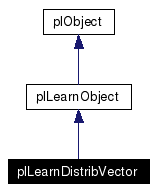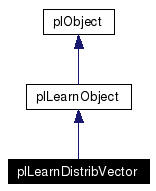
#include <plLearn.h>
Inheritance diagram for plLearnDistribVector:


Public Member Functions | |
| plLearnDistribVector (const vector< plLearnObject * > &learn_objects, const plVariablesConjunction &vars, const vector< bool > &known_range) | |
| Constructs an objects to learn the vector {learn_objects} of learning objects (corresponding to a set of distributions). | |
| plLearnDistribVector (const vector< plLearnObject * > &learn_objects, const plVariablesConjunction &vars) | |
| The same as above the constructor, but {known_range} is assumed to be {true} as value for all variables. | |
| virtual | ~plLearnDistribVector () |
| Destructor. | |
| void | reset () |
| Resets all learning objects. | |
| void | internal_addPoint (const plDataValues &point, double weight=1.0) |
| Adds a point {point} with a given weight {weight} and updates the statistics. | |
| template<class filterArrayT> | |
| void | addFilterNewPoint (const plValues &point, filterArrayT filter, double weight=1.0) |
| Adds a point {point} (represented as a {plValue}) with a given weight {weight} and updates the statistics. | |
| template<class arrayT, class filterArrayT> | |
| void | addFilterNewPoint (arrayT *point, filterArrayT filter, double weight=1.0) |
| Same as above, but {point} is represented as a C array. | |
| template<class arrayT, class filterArrayT> | |
| void | addFilterNewPoint (const vector< arrayT > &point, filterArrayT filter, double weight=1.0) |
| Same as above, but {point} is represented as an STL vector. | |
| template<class singleT, class filterArrayT> | |
| void | addFilterNewPoint (singleT point, filterArrayT filter, double weight=1.0) |
| Same as above, but {point} is a scalar value. | |
| template<class filterArrayT> | |
| void | addFilterPoint (const plDataValues &point, filterArrayT distrib_to_update, double weight=1.0) |
| Same as above, but {point} is represented as an {plDataValues}. | |
Definition at line 357 of file plLearn.h.
|
||||||||||||||||
|
Constructs an objects to learn the vector {learn_objects} of learning objects (corresponding to a set of distributions). {vars} is the set of variables on which learning is performed and {known_range} is a vector of boolean to say, for each variable, if its range is known or not. |
|
||||||||||||||||||||
|
Same as above, but {point} is a scalar value. ATTENTION: this method can only be used for one-dimensional cases. Definition at line 419 of file plLearn.h. References addFilterPoint(). |
|
||||||||||||||||||||
|
Adds a point {point} (represented as a {plValue}) with a given weight {weight} and updates the statistics. {filter} is an array of boolean values to say, for each learning object, if it will be updated or not. Definition at line 391 of file plLearn.h. References addFilterPoint(). |
 1.4.1
1.4.1